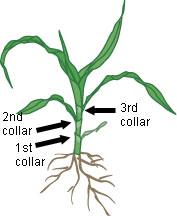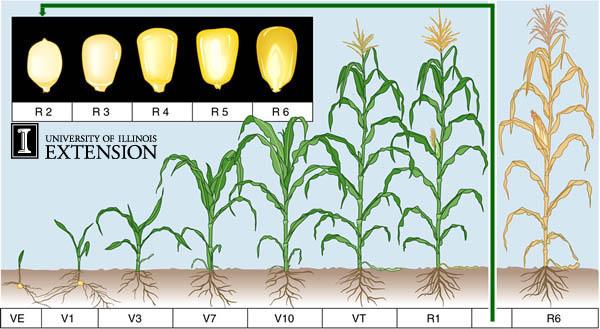Corn Growth Stage Development

Typical corn plants develop 20 to 21 total leaves, silk about 65 days after emergence, and mature around 125 days after emergence. The specific time interval, however, can vary among hybrids, environments, planting date, and location. The length of time between each growth stage, therefore, is dependent upon these circumstances. For example, an early maturing hybrid may produce fewer leaves or progress through the different growth stages at a faster rate than described here. In contrast, a late-maturity hybrid may develop more leaves and progress through each growth stage at a slower pace.
Almost all pest management decisions for corn are based on the vegetative stage. These are identified by the number of collars present on the corn plant. The leaf collar is the light-colored collar-like “band” located at the base of an exposed leaf blade, near the spot where the leaf blade comes in contact with the stem of the plant. Leaves within the whorl, not fully expanded and with no visible leaf collar are not included. For example, a plant with 3 collars would be called a V3 plant, however, there may be 6 leaves showing on the plant.

Growth Stage Descriptions
VE - Emergence
Coleoptile reaches the soil surface and exposure to sunlight causes elongation of the coleoptile and mesocotyl to stop. The growing point, located just above the mesocotyl, is about 0.75 inches below the soil surface. Embryonic leaves rapidly develop and grow through the coleoptilar tip. Seminal root growth begins to slow and nodal roots are initiated at the crown. Weed control at this stage will result in little yield loss, but late-emerging weeds may produce substantial seed, increasing the soil seed bank.
V1 - First leaf collar
Lowermost leaf (short with rounded tip) has a visible leaf collar. Nodal roots begin elongation. Again, weed control at this growth stage will result in little yield loss, but seed from weeds that emerge later in the growing season may contribute to the soil seed bank if a residual herbicide has not been applied.
V3 - Third leaf collar
The growing point remains below the soil surface as little stalk elongation has occurred. Lateral roots begin to grow from the nodal roots and growth of the seminal root system has ceased. All leaves and ear shoots that the plant will produce are initiated at this stage. Since the growing point remains below the soil surface, cold soil temperatures may increase the time between leaf stages, increase the total number of leaves formed, delay tassel formation, and reduce nutrient uptake. Broadcast applications of growth regulating herbicides like 2,4-D or dicamba should be avoided when corn is past the V3 growth stage (approximately 8 inches tall). Drop nozzles may be used past the V3 growth stage. Corn at the V4 growth stage is near or at 12 inches tall. Atrazine and products containing atrazine may not be applied when corn is greater than 12 inches tall. Always check herbicide labels for height restrictions.
V7 - Seven leaf collar
During the V7 and V8 growth stages the rapid growth phase and kernel row determination begins. Senescence of lower leaves may occur if plant is stressed, but must still be counted when staging plants.
Prior stages:
V5: At this stage the uppermost ear and tassel is initiated followed by kernel row number determination. The growing point nears the soil surface as stalk internode elongation begins.
V6: The tassel/growing point is now above the soil surface making plants increasingly vulnerable to above-ground damage. Ear shoot initiation has begun. Signs of nutrient deficiencies at this growth stage are important to correct. Side dressing nitrogen may be performed up the the V8 growth stage if fertilizer is placed in moist soil without excessive root pruning. Also be aware of insect damage (lodged plants). Most ALS-inhibiting herbicides should not be applied after this growth stage. Check herbicide labels.
V10 - Ten leaf collar
At the V9 and V10 growth stages the stalk is in a rapid growth phase accumulating dry matter as well as nutrients. The tassel has begun growing rapidly as the stalk continues to elongate. Many ear shoots are easily visible when the stalk is dissected.
VT - Tasseling
Initiation of the VT stage begins when the last branch of the tassel is visible and silks have not emerged. This stage begins about 2-3 days before silk emergence. The plant is almost at its full height and pollen shed (anthesis) begins. Pollen shed typically occurs in the morning or evening. Plants at the VT/R1 are most vulnerable to moisture stress and leaf loss (hail).
Prior stages:
V12: Kernel row determination is nearly complete, with the number of kernels per row being determined up to the week prior to silking. Soil moisture and nutrient availability are becoming increasingly important.
V15: This stage is the beginning of the most critical period for yield determination. At this point in time, ear shoot development has surpassed that of the lower ear shoots. New leaf stages occur every 1-2 days.
V18: Silks are elongating and brace roots are being formed to support the plant to obtain water and nutrients from the layers of the upper soil surface.
R1 - Silking
This stage begins when any silk is visible outside the husk. Falling pollen grains are captured by the silk and grow down the silk over a 24 hour period ultimately fertilizing the ovule. The ovule becomes a kernel. It takes upwards of three days for all silks on a single ear to be exposed and pollinated. The number of fertilized ovules is determined at this stage. If an ovule is not fertilized, it will not produce a kernel and it eventually degenerates.
Environmental stress at this time is detrimental to pollination and seed set, with moisture stress causing desiccation of silks and pollen grains. Nutrient concentrations in the plant are highly correlated with final grain yield as nitrogen and phosphorous uptake are rapid.
R6 - Physiological Maturity
Occurring approximately 55-65 days after silking, all kernels on the ear have attained maximum dry weight. A black or brown layer has formed where the kernel attaches to the cob, indicating physiological maturity has been attained. The stalk of the plant may remain green, but leaf and husk tissue has lost its green color at this stage. Kernel moisture content ranges from 30-35% at this stage, with much variation among hybrids and environmental conditions.
Information presented on this page obtained from
University of Illinois Extension
and
WeedSoft® — University of Nebraska, Lincoln
